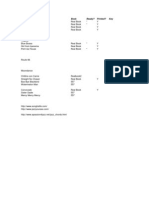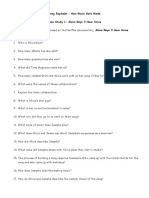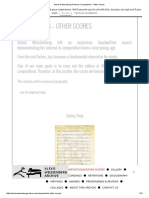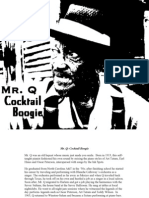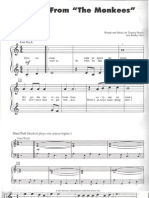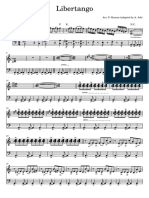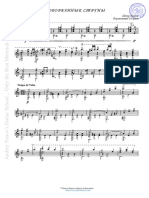Big Adventures Small Harps 1A
Big Adventures Small Harps 1A
Uploaded by
Estella CarrilloCopyright:
Available Formats
Big Adventures Small Harps 1A
Big Adventures Small Harps 1A
Uploaded by
Estella CarrilloCopyright
Available Formats
Share this document
Did you find this document useful?
Is this content inappropriate?
Copyright:
Available Formats
Big Adventures Small Harps 1A
Big Adventures Small Harps 1A
Uploaded by
Estella CarrilloCopyright:
Available Formats
SINGLE USER LICENSE
Permission is granted for ONE person to print ONE copy for
personal use. Digital files may NOT be shared with others.
Published by Music Discoveries
51 Lake Drive, Bedford, Nova Scotia, Canada B4A 1J1
www.musicdiscoveries.shop
Copyright © 2016 Anne Crosby Gaudet
All rights reserved
Level 1A Content
Unit 1 . . . . . . . . . . . . . . . . . . . 4
• Open and closed hand
• Playing with finger 2
• Note name review
• Quarter, half and whole notes
Unit 2 . . . . . . . . . . . . . . . . . . . 12
• Placing 2 fingers
• Brackets
• Stepping up and down
• 4/4 rhythm review
Unit 3 . . . . . . . . . . . . . . . . . . . 20
• Skipping up and down
• 3/4 time signature
• Dotted half note
• Rest values
Unit 4 . . . . . . . . . . . . . . . . . . . 30
• Intervals of 2nd and 3rd
• Solid and broken intervals
• Eighth notes
• Ledger lines
Unit 5 . . . . . . . . . . . . . . . . . . . 39
• 3-note groups
• Linking groups
• Dotted quarter and eighth notes
Big Adventures Small Harps - Level 1A
Single User License 3 Permission to print one copy
Lesson Notes
1
Technique
Welcome to Big Adventures Small Harps! In the first chapter you will review how to read notes
and basic rhythm. But let’s begin at the harp with your hand position and posture. Take your
time learning to open and close the hand properly. Be patient and know that this sets the stage
for beautiful tone and good control.
Open Hand Position
Pretend you are reaching out to shake someone’s
hand. This is the open hand shape for playing the
harp. Notice how the fingers are gently curved and the
thumb is pointed up.
Closed Hand Position
Now close your fingers like you are going to give a fist
bump. Keep your fingers relaxed so the nails don’t
curl under.
• Feet flat
• Tall back
As you sit at the harp, imagine you are a beautiful tree. • Shoulders relaxed
Your feet are the roots, firmly planted. Your back is the
• Float the elbows
trunk, straight and tall. Your arms are the branches,
moving gently in the wind. Your fingers are the leaves. • Breathe
Remember to check your posture. Feeling relaxed and
natural will help you play your best.
Big Adventures Small Harps - Level 1A
Single User License 4 Permission to print one copy
Warm-Ups
The music alphabet has 7 letters. We use these letters to
name our strings. C is red and F is blue.
Use color pencils to trace the C and F strings with the
correct colors.
Open your hand like you are getting ready for a hand shake, is your thumb up? Let’s start with
right hand finger 2 on C. Pluck the string and close your hand position. Remember the fist
bump? Relax your hand. Beautiful!
Let’s do it again. Place your finger 2 on C, close fully when you pluck the string. Relax. Then
open your hand and replace on the next string, D. Keep going!
Close, relax, open, place
Play and name these notes with right hand finger 2. Say, “close relax open place” as you pluck
each string. You may want to print the letter names under every note.
Play and name these notes with left hand finger 2. If your harp has 26 strings the lowest note
you can play is the C in space 2.
Big Adventures Small Harps - Level 1A
Single User License 5 Permission to print one copy
Notes and Patterns
Name and play these notes using right hand finger 2.
Practice “close relax open place” on every note. You Name and play
may want to circle the Cs with red and the Fs with these notes
blue.
Big Adventures Small Harps - Level 1A
Single User License 6 Permission to print one copy
Rhythm Reading
quarter note 1 beat
half note 2 beats Let’s review
some rhythm
basics
whole note 4 beats
time signature
The top number bar line
double bar line
shows the number Divides the music
of beats in each The end
into equal measures
measure
full measure counting
measure or bar
Count the beats as you tap
The distance between the
rhythms or play music
bar lines, this rhythm is
three measures long
Big Adventures Small Harps - Level 1A
Single User License 7 Permission to print one copy
Rhythm Challenge
Practice tapping and counting these rhythms. You could tap the soundboard or tap your lap.
Challenge yourself by using a metronome at different speeds.
Slow Medium Fast
60 88 120
Big Adventures Small Harps - Level 1A
Single User License 8 Permission to print one copy
Quiet Morning
In this piece, all notes are written in the treble clef. Notes with stems pointing down are for the
left hand, and notes with up stems are played with the right hand.
Big Adventures Small Harps - Level 1A
Single User License 9 Permission to print one copy
Try to feel the mood of Daydreams
the piece as you play.
Slow and dreamy
Big Adventures Small Harps - Level 1A
Single User License 10 Permission to print one copy
Theory
Treble Clef Note Review
Name the following treble clef notes:
Bass Clef Note Review
Name the following bass clef notes:
Big Adventures Small Harps - Level 1A
Single User License 11 Permission to print one copy
Lesson Notes
2
Stepping Patterns
Use fingers 2 and 1 to The bracket tells you to
play stepping patterns. place your fingers on both
strings as a group.
Practice this warm-up with your right hand and then with your left hand. Play slowly so you can
focus on closing and opening your hand. Remember to replace both fingers as a group.
open - replace open - replace open - replace
… continue the pattern down to C
open - replace open - replace open - replace
… continue the pattern up to C
Big Adventures Small Harps - Level 1A
Single User License 12 Permission to print one copy
Leap and Land Study
Brackets and Brackets and
fingering below the fingering above
notes will indicate the notes indicate
left hand. right hand.
This study challenges the left hand to cross quickly above the right hand. Train your left hand to
leap and land on the two-note group before the right hand plays. This will be easier to master if
you practice very slowly.
nd
& la
& land p
ap
lea
le
LH
LH
This is a repeat sign.
This is a double bar line. It means repeat the music.
It means the end. It means repeat the music.
Big Adventures Small Harps - Level 1A
Single User License 13 Permission to print one copy
Notes and Patterns
Remember to place both fingers on the strings as a group.
Practice hint: go through the flashes silently by placing your Stepping
fingers on each group and giving the strings a little squeeze. up or down?
Big Adventures Small Harps - Level 1A
Single User License 14 Permission to print one copy
Rhythm Reading
• This is a time signature
• It’s called “four four time”
• There are four quarter note beats in every measure
• This is another time signature
• It’s called “three four time”
• There are three quarter note beats in every measure
Add the full measure counting and bar lines to divide the following rhythms correctly.
Big Adventures Small Harps - Level 1A
Single User License 15 Permission to print one copy
Rhythm Challenge
This activity may challenge your coordination! Play the left hand bass notes on your harp and
tap the right hand rhythm on the sound board or your lap.
Big Adventures Small Harps - Level 1A
Single User License 16 Permission to print one copy
Misty Shores
Peacefully
Big Adventures Small Harps - Level 1A
Single User License 17 Permission to print one copy
Summer Breeze
Slowly
The end.
Back to the
beginning
Big Adventures Small Harps - Level 1A
Single User License 18 Permission to print one copy
Theory
Draw the note that is up a step from the given note. Name both notes.
F G
Draw the note that is down a step from the given note. Name both notes.
F E
Big Adventures Small Harps - Level 1A
Single User License 19 Permission to print one copy
Lesson Notes
3
Skipping Patterns
Skips can move
from space note to
space note…
… or from line
note to line note.
Practice this warm-up with your right hand and then with your left hand. Play slowly so you can
focus on closing and opening your hand. Remember to replace both fingers as a group.
open - replace open - replace open - replace
… continue the pattern down to C
open - replace open - replace open - replace
… continue the pattern up to C
Big Adventures Small Harps - Level 1A
Single User License 20 Permission to print one copy
Leap and Land Study
This study challenges your hands to change positions quickly. Try to “leap and land” each group
before the opposite hand plays. Practice slowly to master this technique.
land
p&
ea
l
LH
The Bounce and Hover
Place right hand 2 and 1 on F and A. Give the strings a little squeeze.
You are going to play and close finger 2 (F) without letting your thumb come off the string. Now
try letting finger 2 bounce off the palm of your hand and hover over the F string so it’s ready to
play again. That’s a bounce and hover. Soon you will be linking groups.
place bounce & hover bounce & hover bounce & hover
I’m hovering!
Big Adventures Small Harps - Level 1A
Single User License 21 Permission to print one copy
Notes and Patterns
Try these practice steps (HOP):
1. Hover your closed hand over the correct strings.
Skipping
2. Open and Place your two fingers as a group.
up or down?
Big Adventures Small Harps - Level 1A
Single User License 22 Permission to print one copy
Rhythm & Counting
Notes Rests
quarter
1 beat
half
2 beats
dotted half
3 beats
whole
4 beats
This is a whole measure rest.
It’s worth the value of a whole measure.
?
So it gets 3 or 4 beats,
depending on the time signature.
Tap and count this rhythm.
Big Adventures Small Harps - Level 1A
Single User License 23 Permission to print one copy
Rhythm Challenge
Tap and count these rhythms with right hand and left hand together.
RH
LH
Big Adventures Small Harps - Level 1A
Single User License 24 Permission to print one copy
Wind Chimes
Swaying
Big Adventures Small Harps - Level 1A
Single User License 25 Permission to print one copy
Big Adventures Small Harps - Level 1A
Single User License 26 Permission to print one copy
Bicycle Ride
Rolling along
Big Adventures Small Harps - Level 1A
Single User License 27 Permission to print one copy
ritardando
a tempo
ritardando
a tempo
ritardando return to the
get slower original speed
Big Adventures Small Harps - Level 1A
Single User License 28 Permission to print one copy
Theory
Draw the note that is up a skip from the given note. Name both notes.
F A
Draw the note that is down a skip from the given note. Name both notes.
F D
Big Adventures Small Harps - Level 1A
Single User License 29 Permission to print one copy
Lesson Notes
4
Intervals
An interval is the distance
between two notes or two strings.
An interval of a 2nd An interval of a 3rd
is the same as a step. is the same as a skip.
These are broken intervals.
Play one note at a time.
These are solid intervals.
Play both notes at the same time.
Play this exercise to practice solid intervals. Remember to fully close and relax your hand, then
hover, open and place (HOP) on the next interval. Try your left hand too.
Big Adventures Small Harps - Level 1A
Single User License 30 Permission to print one copy
Interval Study
When the hand changes position, remember to place both fingers as a group. Placing early will
help you feel relaxed and the music will flow more smoothly.
The Bounce and Hover
Place right hand 2 and 1 on F and A.
You are going to play and close your thumb (A) without letting your finger 2 come off the string.
Now let the thumb bounce back and hover over the A string so it’s ready to play again. That’s a
bounce and hover. You are almost ready to link groups!
I’m hovering! place bounce & hover bounce & hover bounce & hover
Big Adventures Small Harps - Level 1A
Single User License 31 Permission to print one copy
Notes and Patterns
Try these practice steps (HOP):
3rd?
1. Hover your closed hand over the correct strings.
2. Open and Place your two fingers as a group. 2nd?
Big Adventures Small Harps - Level 1A
Single User License 32 Permission to print one copy
Rhythm & Counting
1 quarter note 2 eighth notes 1 quarter rest
1 beat 1 beat 1 beat
Clap and count the following rhythms.
Big Adventures Small Harps - Level 1A
Single User License 33 Permission to print one copy
Rhythm Challenge
Play the right hand intervals on your harp and tap the left hand rhythm on the soundboard.
LH
Big Adventures Small Harps - Level 1A
Single User License 34 Permission to print one copy
Lavender Fields
Remember these? ritardando slow down gradually
D.C. al Fine repeat from the beginning
Fine the end
Flowing
Middle E
Big Adventures Small Harps - Level 1A
Single User License 35 Permission to print one copy
High A
Big Adventures Small Harps - Level 1A
Single User License 36 Permission to print one copy
Silver Moon
Calm and quiet
High C
Big Adventures Small Harps - Level 1A
Single User License 37 Permission to print one copy
Theory
Did you notice some new notes in your pieces lately? Sometimes we need to extend the staff by
using ledger lines. In the treble clef, High A, B and C need ledger lines. Play these high notes
on your harp.
1. Draw the following ledger line notes above the treble staff.
When the left hand needs to play above Middle C, the notes could be written in the treble clef or
we can use ledger lines in the bass clef. Play these notes with your left hand.
2. Draw the following ledger line notes above the bass staff.
Big Adventures Small Harps - Level 1A
Single User License 38 Permission to print one copy
5 Lesson Notes
Placing 3-Note Patterns
Place your fingers on the three strings as a group. Practice each hand slowly and then play
hands together. The comma means to lift and replace your fingers as a group. Each pattern will
continue for eight repetitions.
continue
continue
continue
continue
Big Adventures Small Harps - Level 1A
Single User License 39 Permission to print one copy
Linking Groups
Remember the bounce and hover? Practice these warm-ups again.
I’m hovering! place bounce & hover bounce & hover bounce & hover
place bounce & hover bounce & hover bounce & hover
When you have two groups moving in opposite directions you can link them together using your
bounce and hover technique.
up 3rd down 2nd link them together
Carefully practice these steps so you can learn how to link groups. Step #3 is the tricky part:
1. Place 2-1 on C and E
2. Play C (bounce and hover over the D)
3. At the same time, replace D (finger 2) and play E (thumb) We’re linking!
4. Play D (close finger 2)
5. Replace and do it again…
Big Adventures Small Harps - Level 1A
Single User License 40 Permission to print one copy
Notes and Patterns
Try these practice steps (HOP): Place three fingers
1. Hover your closed hand over the correct strings. as a group.
2. Open and Place your three fingers as a group.
Big Adventures Small Harps - Level 1A
Single User License 41 Permission to print one copy
Rhythm & Counting
dotted quarter note 1 1/2 beats
eighth note 1/2 beat
Practice clapping and counting these mini rhythms. Set a metronome to 60.
Clap and count each line.
Big Adventures Small Harps - Level 1A
Single User License 42 Permission to print one copy
Rhythm Challenge
Add the missing bar lines and full measure counting.
Clap the rhythms and count out loud.
Big Adventures Small Harps - Level 1A
Single User License 43 Permission to print one copy
The Fairy Garden
Playfully
Repeat
lines 3 and 4
Big Adventures Small Harps - Level 1A
Single User License 44 Permission to print one copy
Leprechaun Dance This piece uses only
white strings!
Lively
Big Adventures Small Harps - Level 1A
Single User License 45 Permission to print one copy
When you use patterns to make your own music that’s called
improvising.
Explore the sound of the white strings and improvise a song of your
own. Try to keep a steady pulse as you play. The white strings create a
special type of scale called pentatonic.
For a fun project, go back to page 25 and improvise your own song using the Rhythm
Challenge exercise and white strings on the harp.
Big Adventures Small Harps - Level 1A
Single User License 46 Permission to print one copy
Theory
Write the name of each note and how many beats it receives.
Name Beats
Big Adventures Small Harps - Level 1A
Single User License 47 Permission to print one copy
You might also like
- Theory Practice Paper 2023 Grade 5 ADocument10 pagesTheory Practice Paper 2023 Grade 5 Arui chen100% (1)
- Jazz Combo ChartsDocument2 pagesJazz Combo Chartstcsjazz38% (8)
- I Thought You Wanted To Dance - Piano SoloDocument9 pagesI Thought You Wanted To Dance - Piano SoloeleanordhallNo ratings yet
- Song Exploder Alicia Keys AnswersDocument4 pagesSong Exploder Alicia Keys Answerscmcma0531No ratings yet
- Kidz Bop SongsDocument6 pagesKidz Bop Songsjspace87No ratings yet
- Grade 5 Theory Revision NotesDocument6 pagesGrade 5 Theory Revision Noteskrt890100% (10)
- Song Title: Revel, My Friends: Ethnic/Geographic Origin: American, Composed (Music by Nancy Silber, Words by Tony Soll)Document2 pagesSong Title: Revel, My Friends: Ethnic/Geographic Origin: American, Composed (Music by Nancy Silber, Words by Tony Soll)kevin8gerzevitzNo ratings yet
- Martin Taylor Walking BassDocument4 pagesMartin Taylor Walking BassorlandoNo ratings yet
- Cifrado Coldplay - Christmas LightsDocument3 pagesCifrado Coldplay - Christmas LightsRicardo EscorcioNo ratings yet
- Lion King LyricsDocument4 pagesLion King LyricsJuan M. HablaNo ratings yet
- Stille Nacht, Heilige Nacht: A o A P S S A I oDocument1 pageStille Nacht, Heilige Nacht: A o A P S S A I oZoppo TrumpNo ratings yet
- Winnie The Pooh For Alto Saxophone PDFDocument8 pagesWinnie The Pooh For Alto Saxophone PDFtania_leon_11No ratings yet
- Jeopardy Orchestra Class - Busy AcitivityDocument27 pagesJeopardy Orchestra Class - Busy AcitivitycellobearNo ratings yet
- Alexis Weissenberg Archive - Compositions - Other ScoresDocument12 pagesAlexis Weissenberg Archive - Compositions - Other Scoresbenny100% (1)
- Searching My Soul - Vonda ShepardDocument2 pagesSearching My Soul - Vonda ShepardTeele TaliNo ratings yet
- Missing You Sheet Music by John Waite Piano Vocal PDFDocument5 pagesMissing You Sheet Music by John Waite Piano Vocal PDFNatania Sanjaya0% (1)
- First Periodical Exam in MAPEH 3Document2 pagesFirst Periodical Exam in MAPEH 3kentjames corales88% (8)
- Latin Set: Peter MartinDocument29 pagesLatin Set: Peter Martinvurrego67% (3)
- Viennese Bass Method - Lesson 1 Scales - Letter FormatDocument5 pagesViennese Bass Method - Lesson 1 Scales - Letter FormatDaniel Fuenzalida TapiaNo ratings yet
- GOAT MusicDocument26 pagesGOAT Musicpatrick puissardNo ratings yet
- MR Q - Cocktail Boogie Liner NotesDocument15 pagesMR Q - Cocktail Boogie Liner NotesmusicmakerbluesNo ratings yet
- Mad World Sheet Music For Piano (Solo)Document1 pageMad World Sheet Music For Piano (Solo)1234456No ratings yet
- Ain't No Way - Lead SheetDocument3 pagesAin't No Way - Lead SheetNel Gómez0% (1)
- Lego House Sheet Music PDFDocument4 pagesLego House Sheet Music PDFAidan WisemanNo ratings yet
- Mark MasonDocument29 pagesMark MasonCAILNo ratings yet
- Will Ye Go LassieDocument4 pagesWill Ye Go LassieAnonymous LvGJBEbwYNo ratings yet
- Chrono Trigger - Peaceful Days PDFDocument2 pagesChrono Trigger - Peaceful Days PDFBlake Clinton Y. DyNo ratings yet
- Woody Allen - Songs From Woody Allen's FilmsDocument1 pageWoody Allen - Songs From Woody Allen's FilmsSomeday JohnnyNo ratings yet
- Christmas Song - Like It's Christmas by Jonas BrothersDocument2 pagesChristmas Song - Like It's Christmas by Jonas Brotherslaurasc2909No ratings yet
- Mama Spice GirlsDocument2 pagesMama Spice GirlsJulio ManzanoNo ratings yet
- Christmas Songs - LyricsDocument6 pagesChristmas Songs - LyricskrismirNo ratings yet
- A Step-By-Step Guide To SingingDocument7 pagesA Step-By-Step Guide To SingingseduckNo ratings yet
- Those Were The DaysDocument1 pageThose Were The DaysgeomyNo ratings yet
- Daisy BellDocument1 pageDaisy BellPhilip FarrowNo ratings yet
- Very First Harp Pie 00 P AreDocument8 pagesVery First Harp Pie 00 P ArewongyinlaiNo ratings yet
- Speecharts Syllabus 2011Document102 pagesSpeecharts Syllabus 2011Krystal Jane SalvadorNo ratings yet
- Poetic Waltz Op. 43 No. 3Document1 pagePoetic Waltz Op. 43 No. 3Anna KompanNo ratings yet
- The MonkeesDocument2 pagesThe MonkeesAustinShope100% (2)
- Morrison's Jig Piano SheetDocument4 pagesMorrison's Jig Piano SheetAmelia TanNo ratings yet
- Thula Klizeo Teaching ProcessDocument2 pagesThula Klizeo Teaching Processapi-273673590100% (1)
- Barbershop Voice Parts VoicingDocument1 pageBarbershop Voice Parts VoicingYoungNo ratings yet
- Balance Ton Quoi.Document4 pagesBalance Ton Quoi.Philippe JavelleNo ratings yet
- Family Sing-A-LongDocument169 pagesFamily Sing-A-LongSanthan ReddyNo ratings yet
- 6th Grade Choir WorksheetDocument2 pages6th Grade Choir Worksheetpenguin115No ratings yet
- Libertango PianoDocument5 pagesLibertango PianoIbraheemAlAmeediNo ratings yet
- 006 Peter Gunn and TextureDocument2 pages006 Peter Gunn and TextureMrAndrewsCHSNo ratings yet
- HK Phil 1718 Subscription BrochureDocument68 pagesHK Phil 1718 Subscription BrochuresdavidkychNo ratings yet
- David Bowie StayDocument2 pagesDavid Bowie StayflgrhnNo ratings yet
- Circle of 5thDocument1 pageCircle of 5thapi-367429991No ratings yet
- Emi20 2011Document17 pagesEmi20 2011Universal Music CanadaNo ratings yet
- Burn Butcher BurnDocument4 pagesBurn Butcher BurnAnn MakarovaNo ratings yet
- So Close - Enchanted - Disney - 2007Document4 pagesSo Close - Enchanted - Disney - 2007EvelynAdelaideNo ratings yet
- Sister Golden HairDocument1 pageSister Golden HairAndré LenzNo ratings yet
- A Fox Went OutDocument1 pageA Fox Went OutpaulnichNo ratings yet
- One-Way-or-Another-One Direction PDFDocument5 pagesOne-Way-or-Another-One Direction PDFDenise PeresNo ratings yet
- Hey, Good Lookin'Document1 pageHey, Good Lookin'Žvainys IvanauskasNo ratings yet
- DOWNTOWN by Petula ClarkDocument1 pageDOWNTOWN by Petula ClarkomaradnanNo ratings yet
- Satie - Three Pieces in The Shape of A PearDocument31 pagesSatie - Three Pieces in The Shape of A PearJessica Ranft50% (2)
- How To Read Ukulele TabsDocument1 pageHow To Read Ukulele TabsAndrea Nortje0% (1)
- Jake Edm PowerpointDocument13 pagesJake Edm Powerpointapi-351011698No ratings yet
- SnowDocument2 pagesSnowriperezbNo ratings yet
- Kirbys Epic Yarn - Mushroom RunDocument3 pagesKirbys Epic Yarn - Mushroom RunMilesNo ratings yet
- Vocals Female Grade Seven SampleDocument4 pagesVocals Female Grade Seven SampleMaria Alvina ANo ratings yet
- Cifra Club - Imagine Dragons - BelieverDocument4 pagesCifra Club - Imagine Dragons - BelieverzampisaxNo ratings yet
- A Queerly Joyful Noise: Choral Musicking for Social JusticeFrom EverandA Queerly Joyful Noise: Choral Musicking for Social JusticeNo ratings yet
- Workload Analysis Using Modified Full Time EquivalDocument11 pagesWorkload Analysis Using Modified Full Time EquivalEstella CarrilloNo ratings yet
- Ucufactsheet FeriskassessmentDocument7 pagesUcufactsheet FeriskassessmentEstella CarrilloNo ratings yet
- Tetra Pak Index 2023 Full ReportDocument38 pagesTetra Pak Index 2023 Full ReportEstella CarrilloNo ratings yet
- The Atlas March - Cloud AtlasDocument4 pagesThe Atlas March - Cloud AtlasEstella CarrilloNo ratings yet
- Dead Souls' DanceDocument3 pagesDead Souls' DanceLeung Ho Yat HollisNo ratings yet
- Dominant Seventh Sharp Ninth Chord - WikipediaDocument7 pagesDominant Seventh Sharp Ninth Chord - WikipediaJohn EnglandNo ratings yet
- Analysis The Midnight ExpressDocument2 pagesAnalysis The Midnight Expressnakasan3107No ratings yet
- Jazz Classics - For Fingerstyle Guitar - 14 Pag PDFDocument14 pagesJazz Classics - For Fingerstyle Guitar - 14 Pag PDFPietro Parco90% (10)
- Trumpet, Cornet, Flugelhorn GRADE 8Document3 pagesTrumpet, Cornet, Flugelhorn GRADE 8Okiki GideonNo ratings yet
- Legendary Fingerpicking PatternsDocument62 pagesLegendary Fingerpicking PatternsDiem Khoa PhanNo ratings yet
- Jamb Syllabus 2024 For MusicDocument8 pagesJamb Syllabus 2024 For MusicOluwaranti HmpNo ratings yet
- CH 02Document8 pagesCH 02talkwithlakshmi3818No ratings yet
- The Saxophone Quartet 5: Richard InghamDocument10 pagesThe Saxophone Quartet 5: Richard Inghambjburt2552No ratings yet
- Rachmaninoff - Variations On A Theme of Corelli, Op.42Document31 pagesRachmaninoff - Variations On A Theme of Corelli, Op.42김준면그림자No ratings yet
- Joao Gilberto Valsa Como Sao Lindos Os YoguisDocument8 pagesJoao Gilberto Valsa Como Sao Lindos Os YoguisGabriel HernandesNo ratings yet
- Sample Activity Sheets in Music 10 Quarter 3, Week 1: MelcsDocument9 pagesSample Activity Sheets in Music 10 Quarter 3, Week 1: MelcsRachel Yam 3nidadNo ratings yet
- MD Classical Cat 480-492Document13 pagesMD Classical Cat 480-492pfood25No ratings yet
- THE GALINYPARIS-CHE$Bt METHODocument27 pagesTHE GALINYPARIS-CHE$Bt METHORafael Rodrigues da SilvaNo ratings yet
- Andante: "Broken Strings" Old Russian Waltz Music By: P.Gapon Arr. For Guitar O.KrohaDocument3 pagesAndante: "Broken Strings" Old Russian Waltz Music By: P.Gapon Arr. For Guitar O.Krohahuong trinhNo ratings yet
- Pe 112 - Lo11Document4 pagesPe 112 - Lo11Nikkaa XOXNo ratings yet
- Romantique Period: 1810 - 1900: Wisnu W. Soedibjo Music History, Indonesia Piano Art (IPA)Document5 pagesRomantique Period: 1810 - 1900: Wisnu W. Soedibjo Music History, Indonesia Piano Art (IPA)Fransiskus Arnoldo WNo ratings yet
- David LangDocument7 pagesDavid LangLuca AvieNo ratings yet
- All My LifeDocument15 pagesAll My LifeRJNo ratings yet
- Soundbridge IVDocument4 pagesSoundbridge IVapi-213601066No ratings yet
- French Suite No. 6 BWV 817 by J.S. Bach For Piano SoloDocument10 pagesFrench Suite No. 6 BWV 817 by J.S. Bach For Piano SoloKlas Krantz100% (1)
- The Speed: For Symphonic OrchestraDocument35 pagesThe Speed: For Symphonic OrchestraПлатон Николаевич БуравицкийNo ratings yet
- Fingerpicking Country Blues GuitarDocument31 pagesFingerpicking Country Blues GuitarJerry Turner97% (36)

